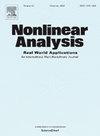具有滑移边界条件的二维可压缩Navier-Stokes方程大解的大时间行为
IF 1.8
3区 数学
Q1 MATHEMATICS, APPLIED
引用次数: 0
摘要
研究二维正压可压缩Navier-Stokes方程在滑移边界条件下的初边值问题。在密度从上到下均匀有界的假设下,我们研究了其相关平衡解的收敛性和指数衰减率。分析是基于初等能量法、爆破判据技术和一些新的速度梯度估计。本文章由计算机程序翻译,如有差异,请以英文原文为准。
Large-time behavior of large solutions to the 2D compressible Navier–Stokes equations with slip boundary conditions
This paper is concerned with an initial-boundary value problem of 2D barotropic compressible Navier–Stokes equations subject to slip boundary conditions. Under the assumption that the density is uniformly bounded from above, we study the convergence of the solutions to its associated equilibrium with an exponential decay rate. The analysis is based on the elementary energy methods, the techniques from blow-up criterion and some new estimates for the gradient of velocity.
求助全文
通过发布文献求助,成功后即可免费获取论文全文。
去求助
来源期刊
CiteScore
3.80
自引率
5.00%
发文量
176
审稿时长
59 days
期刊介绍:
Nonlinear Analysis: Real World Applications welcomes all research articles of the highest quality with special emphasis on applying techniques of nonlinear analysis to model and to treat nonlinear phenomena with which nature confronts us. Coverage of applications includes any branch of science and technology such as solid and fluid mechanics, material science, mathematical biology and chemistry, control theory, and inverse problems.
The aim of Nonlinear Analysis: Real World Applications is to publish articles which are predominantly devoted to employing methods and techniques from analysis, including partial differential equations, functional analysis, dynamical systems and evolution equations, calculus of variations, and bifurcations theory.

 求助内容:
求助内容: 应助结果提醒方式:
应助结果提醒方式:


